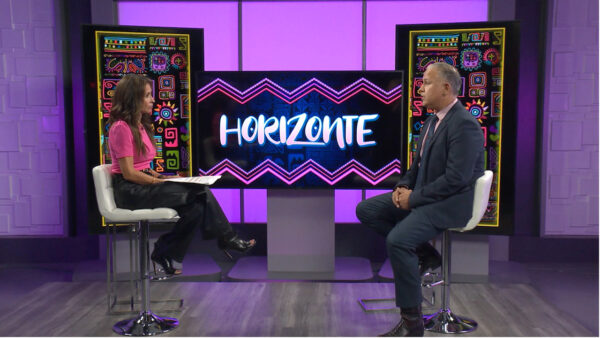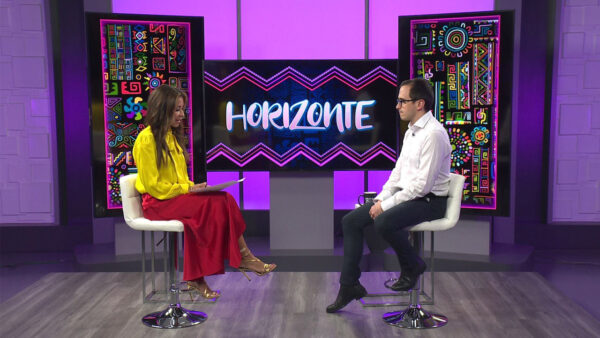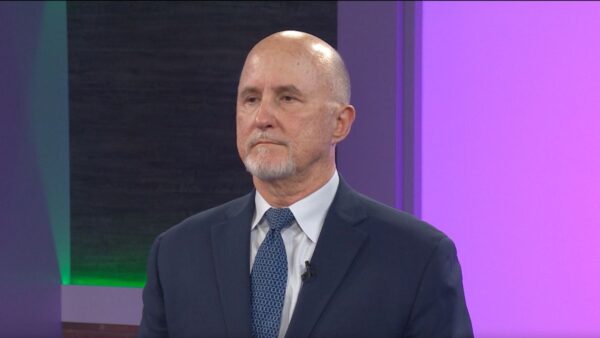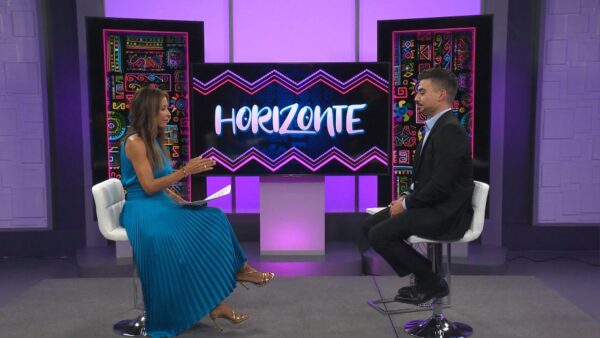Wooden chairs created by craftsmen from Alamos, Sonora, in Mexico are being turned into works of art by Scottsdale students and adult artists in the Scottsdale sister-city project “Las Sillas de Alamos” (The Chairs of Alamos). “Las Sillas de Alamos” is a cultural exchange project between Alamos and Scottsdale. The chairs are fashioned after a bishop’s chair from the colonial church in Alamos, which was established in the 1700’s. Scottsdale-Alamos City Project Coordinator Bob Rink; and Daniela Alcazar, a student artist and Alamos exchange student from Chaparral High School, discuss the project.
Jose Cardenas: Wooden chairs from Mexico are being turned into works of art by Scottsdale students and adult artists. Joining me to talk about this project called Las Sillas De Alamos are Bob rink, Scottsdale, Alamos city project coordinator, Daniela Alcazar, a student artist and Alamos exchange student. Let's talk generally about the student exchange program and the work with Alamos. Maybe you can give us a history of the relationship between the two cities.
Bob Rink: I believe the relationship is 25 years old. I just joined the group in the last two or three years. Each year there have been high school students going between Scottsdale and Alamos on annual basis and we have an exchange program between the elementary school students via letters and skype calls.
Jose Cardenas: And tell us a little bit about Alamos.
Bob Rink: Alamos is a colonial city in southern Sonora that's been around probably since the 1700s. It's beautiful, beautiful city in the mountains on the southern ends of Sonora.
Jose Cardenas: I understand one of the richest cities in the world at one time because of the Silver mining.
Bob Rink: Correct. I believe most of the churches and missions throughout the southwest, the United States, northwest Mexico, I'm sure a number of wars were funded by the mines of Alamos.
Jose Cardenas: So let's talk about the student exchange program. We have a picture to put on the screen of the students, I think it's the most recent class, Daniela, who went down to Alamos and your come patriots there, your counterparts.
Daniela Alcazar: Yes. That's a picture of us. We went to a competition in one of the schools nearby. We went to --
Jose Cardenas: Is this in Alamos?
Daniela Alcazar: Yes. There was an exchange student last spring break where eight students from the Scottsdale area went down to Alamos, and we stayed in the Alamos home and we went to the school and we kinds of almost integrated into the community for a week.
Jose Cardenas: Then they will be coming up here?
Daniela Alcazar: They will be coming in April.
Jose Cardenas: Bob, this particular project, how did it come about?
Bob Rink: One of our committee members was aware of communities painting cows, horses and guitars. We came up with an idea of art in chairs. That's the idea. We figured out that we could ask some carpenters in Alamos to create these chairs, a base of a chair, then we would have the Scottsdale artists and art students paint them. They still are on sale. We have sold half of them. Half are still on exhibit in Scottsdale at the Arizona artist alliance show room, which is at the 101 and Indian bends wash.
Jose Cardenas: How did you go about deciding who would participate in the painting of the chairs?
Bob Rink: One of our committee members approached a number of art organizations in Scottsdale and the artists alliance was the first one to pop up. We also approached the high school art programs which Daniela was recruited through that.
Jose Cardenas: It wasn't necessarily the students who were part of the exchange program but students who were selected specifically for this particular project.
Bob Rink: Correct.
Jose Cardenas: We have a picture to put up on the screen of people actually working on the chairs. Daniela, as I understand it, some of these you have artists working on some, you have artists, students, then somebody like you. You work by yourself on one of these.
Daniela Alcazar: It was a mix of lots of people there were adult artists. There was student artists and groups from the art program at schools, different high schools in Scottsdale, that volunteered their time and they created these beautiful pieces of art.
Jose Cardenas: Were you given any kinds of guidelines or restrictions in terms of what you could do?
Daniela Alcazar: Not really. You really just do whatever you feel that will Rae reflect an emotion, kind of like also they told us to look at really like how the Mexican and the American students like the artists how we can elaberate on that. There was lots of different types of artwork.
Jose Cardenas: Did they give you suggestions for themes?
Daniela Alcazar: Native American, there was also things about lots of modern art. There was contemporary art. Really what the artist feels would be good.
Jose Cardenas: The ends result, we have a picture of how many chairs, about 15?
Bob Rink: Correct.
Jose Cardenas: We have a picture that we'll put up on the screen. These are some of the ones that were for sale.
Bob Rink: Daniela's is on the right. The blue one, with the blue seat. That would be on the left of the screen there.
Daniela Alcazar: The one with the dream catcher.
Jose Cardenas: So Daniela, tell us about that. What were you trying to do?
Daniela Alcazar: I really like the idea of how we can incorporate like Native American with American culture, and the dream catcher and the patterns kinds of reflect the details that they put into their artwork. I know lots of history and art museums in Arizona and Scottsdale show a lot of these Native American artworks. Recently, my art group, my art club, we went on a field trip to the art museum and I saw lots of these types of art.
Jose Cardenas: That was your inspiration?
Daniela Alcazar: Yes.
Jose Cardenas: Bob, how many chairs were sold?
Bob Rink: Nine were sold on our opening evening. There are six left.
Jose Cardenas: At $300 apiece. What are you doing with the money?
Bob Rink: They will help funds our student exchanges between Scottsdale and Alamos.
Jose Cardenas: How much does it cost to sends students down there and to bring students up?
Bob Rink: You know -- I haven't been around long enough to know the dollar and cents of it all. We have transportation by bus. The home stays are in people's homes. There's a little hosting at some of the restaurants. I can't give you an exact dollar figure but it's probably $150 per student.
Jose Cardenas: This is a question for both of you. I think you may have different perspectives. Bob, it's no secret that times currently tensions have been tight between Arizona and its sister state of Sonora. Have you noticed any of that and has it impacted the work that you have been doing for the sister city?
Bob Rink: I actually tried to ignore our legislation up here and I don't think it's had any effect on my efforts. I tend to be dealing on a people to people basis as opposed to government to government, so I haven't noticed anything.
Jose Cardenas: Daniela, what about when you went to Alamos. Did you notice any difference in attitudes? Did people treat you differently because of what's been going on in Arizona?
Daniela Alcazar: No, they were very welcoming. The city is very beautiful and its culture is very rich. The community is a little different than the American community. It's a little more connected. Neighbors knew the neighbors. Everybody knew each other. Everybody would welcome me.
Jose Cardenas: You felt very welcome.
Daniela Alcazar: Yes. But also they didn't have as much materialistic things that we do. Like hot water was a problem sometimes. The school, the class rooms were a little bit differences. But it's not a set off for them.
Jose Cardenas: I apologize. That's all the time we have left. Thank you both for coming to talk about this great project. That is our show for tonight from all of us at Horizonte I'm Jose Cardenas. Have a good evening.
Bob Rink:Coordinator, Scottsdale-Alamos City Project; Daniela Alcazar:Student Artist and Alamos Exchange Student, Chapparal High School;




















